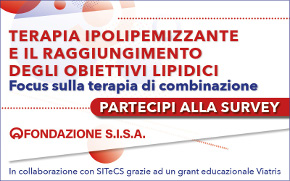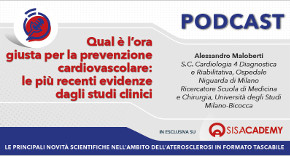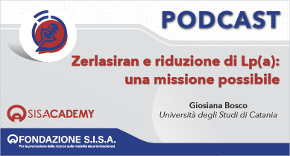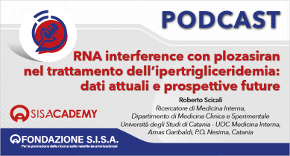 Rivista in lingua italiana
Rivista in lingua italiana
riservata ai Soci SISA
Ultimo numero:
Anno 16 • N.1/2025
SISANews
La scelta dei pazienti da trattare con inibitori di PCSK9 dovrebbe basarsi sulla massimizzazione del rapporto rischio/beneficio
Sebbene le attuali linee guida europee e statunitensi indichino l'uso di inibitori PCSK9 come appropriato in pazienti specifici, il ricorso a questi farmaci è basso, in gran parte a causa del loro costo percepito, e al momento sembra più opportuno basare l'uso di questi agenti su una stratificazione dei pazienti in funzione del rapporto rischio/beneficio in specifici sottogruppi, piuttosto che promuoverne l’adozione incondizionata nella prevenzione secondaria. Tale stratificazione può basarsi su diversi elementi, tra cui l’alto tasso di incidenza di eventi al basale che caratterizza soggetti con malattia multivasale, con patologia cardiovascolare aterosclerotica e comorbilità, come la malattia renale cronica o il diabete con complicanze vascolari o pazienti FH che hanno sperimentato un evento CV.
![]()
'Highest risk-highest benefit' strategy: a pragmatic, cost-effective approach to targeting use of PCSK9 inhibitor therapies
Annemans L, Packard CJ, Briggs A, Ray KK.
Eur Heart J 2018;39:2546-2550
Cholesterol carried in low-density lipoprotein cholesterol (LDL-C) and other apolipoprotein B-containing lipoproteins plays a causal role in atherogenesis, and, accordingly, is a key target in the prevention of atherosclerotic cardiovascular disease (ASCVD). Clinical trial evidence indicates that the magnitude of the benefit from LDL-C lowering is independent of the means by which it is achieved and is proportionate to the absolute decrease in lipoprotein level. Further, the relative risk reduction (RRR) appears the same, regardless of patient demographics and background medical history. Most guidelines (e.g. Piepoli et al 2016) recommend goals for LDL-C lowering that, while somewhat artificial and idealized constructs because the association between LDL-C and risk is continuous, have been useful clinically as a metric of therapeutic success. In clinical practice, however, not all patients achieve their LDL-C goal with statins alone, and increasing recognition of this treatment gap has led to the need to consider the routine use of combination lipid-lowering therapies.
The cholesterol absorption inhibitor ezetimibe added to statin achieves an incremental reduction in LDL-C of typically 20–25% and has been shown to provide a further decrease in ASCVD risk. Hence, this agent is now recommended for patients not achieving their lipid goal on maximum tolerated statin dose. Recently, the introduction of proprotein convertase subtilisin/kexin type 9 (PCSK9) inhibitors has made possible more profound LDL-C lowering of the order of 50–60%, and both currently marketed agents—evolocumab and alirocumab—have been approved for use in selected patient groups [those with severe ASCVD and those with primary hypercholesterolaemia, especially familial hypercholesterolaemia (FH)] with an inadequate response to maximally tolerated statin therapy or statin intolerance. With the publication of the FOURIER trial, we have evidence that the addition of PCSK9 inhibitors to statin delivers significant reduction in the risk of cardiovascular events, in line with the predicted benefit from meta-regression analysis...

Area Soci
Eventi
39° Congresso Nazionale
 39° Congresso Nazionale
39° Congresso NazionaleRoma, 23-25 novembre 2025
Save the date




 Spring Meeting Gruppi Giovani SID, SIGG, SIIA, SIMI, SIPREC, SISA
Spring Meeting Gruppi Giovani SID, SIGG, SIIA, SIMI, SIPREC, SISARimini, 6-8 aprile 2025
[continua a leggere]
 SISA LIPID ACADEMY - Corso avanzato di lipidologia clinica
SISA LIPID ACADEMY - Corso avanzato di lipidologia clinicaModena, 4-5 Luglio 2024
[continua a leggere]Giornale Italiano Arteriosclerosi
HoFH today
 Rivista Italiana della
Rivista Italiana della
Ipercolesterolemia
Familiare Omozigote
Anno 6 • N.1/2024
Rivista NMCD
Diateca
[continua a leggere]
[continua a leggere]
Newsletter
il vostro indirizzo di posta elettronica
Progetto LIPIGEN

Nuovo sito dedicato al Progetto LIPIGEN
Progetto LIPIGEN - Vecchio portale
E' necessario essere loggati come utente
Lipigen per poter accedere alla pagina
PROject Statin Intolerance SISA
PROSISA – PROject Statin Intolerance SISA
E' necessario essere loggati come utente
PROSISA per poter accedere alla pagina
GILA - Lipoprotein Aferesi
Gruppo Interdisciplinare Lipoprotein Aferesi
(Accesso Gruppo GILA-Lipoprotein Aferesi)
E' necessario essere loggati come utente del Gruppo GILA per poter accedere
Gruppo Interdisciplinare Lipoprotein Aferesi
(Documentazione ad accesso libero)
Pagina informativa per medici e pazienti










